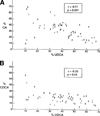Biliary bile acids in primary biliary cirrhosis: effect of ursodeoxycholic acid
- PMID: 10347103
- PMCID: PMC4004074
- DOI: 10.1002/hep.510290618
Biliary bile acids in primary biliary cirrhosis: effect of ursodeoxycholic acid
Abstract
Bile acid composition in fasting duodenal bile was assessed at entry and at 2 years in patients with primary biliary cirrhosis (PBC) enrolled in a randomized, double-blind, placebo-controlled trial of ursodeoxycholic acid (UDCA) (10-12 mg/kg/d) taken as a single bedtime dose. Specimens were analyzed by a high-pressure liquid chromatography method that had been validated against gas chromatography. Percent composition in bile (mean +/- SD) for 98 patients at entry for cholic (CA), chenodeoxycholic (CDCA), deoxycholic (DCA), lithocholic (LCA), and ursodeoxycholic (UDCA) acids, respectively, were 57.4 +/- 18.6, 31.5 +/- 15.5, 8.0 +/- 9.3, 0.3 +/- 1.0, and 0.6 +/- 0.9. Values for CA were increased, whereas those for CDCA, DCA, LCA, and UDCA were decreased when compared with values in normal persons. Bile acid composition of the major bile acids did not change after 2 years on placebo medication. By contrast, in patients receiving UDCA for 2 years, bile became enriched with UDCA on average to 40.1%, and significant decreases were noted for CA (to 32.2%) and CDCA (to 19.5%). No change in percent composition was observed for DCA and LCA. Percent composition at entry and changes in composition after 2 years on UDCA were similar in patients with varying severity of PBC. In patients whose bile was not enriched in UDCA (entry and placebo-treated specimens), CA, CDCA, DCA, and the small amount of UDCA found in some of these specimens were conjugated to a greater extent with glycine (52%-64%) than with taurine (36%-48%). Treatment with UDCA caused the proportion of all endogenous bile acids conjugated with glycine to increase to 69% to 78%, while the proportion conjugated with taurine (22%-31%) fell (P <.05). Administered UDCA was also conjugated predominantly with glycine (87%).
Figures



 ), UDCA < 5%; (
), UDCA < 5%; ( ), UDCA > 30%.
), UDCA > 30%.Similar articles
-
Cytotoxicity of bile salts against biliary epithelium: a study in isolated bile ductule fragments and isolated perfused rat liver.Hepatology. 1997 Jul;26(1):9-21. doi: 10.1002/hep.510260102. Hepatology. 1997. PMID: 9214446
-
[Studies on pruritus in obstructive jaundice cases with special references to serum bile acid fractions].Fukuoka Igaku Zasshi. 1991 Aug;82(8):445-57. Fukuoka Igaku Zasshi. 1991. PMID: 1937344 Japanese.
-
Cholic acid and ursodeoxycholic acid therapy in primary biliary cirrhosis. Changes in bile acid patterns and their correlation with liver function.Eur J Clin Pharmacol. 1993;45(3):221-5. doi: 10.1007/BF00315387. Eur J Clin Pharmacol. 1993. PMID: 8276045 Clinical Trial.
-
Ursodeoxycholic acid for chronic liver diseases.J Clin Gastroenterol. 1988;10 Suppl 2:S25-31. J Clin Gastroenterol. 1988. PMID: 3062082 Review.
-
Ursodeoxycholic acid (UDCA) in the treatment of chronic cholestatic diseases.Biochimie. 1991 Oct;73(10):1335-8. doi: 10.1016/0300-9084(91)90098-l. Biochimie. 1991. PMID: 1782227 Review.
Cited by
-
Ursodeoxycholic acid therapy in gallbladder disease, a story not yet completed.World J Gastroenterol. 2013 Aug 21;19(31):5029-34. doi: 10.3748/wjg.v19.i31.5029. World J Gastroenterol. 2013. PMID: 23964136 Free PMC article. Review.
-
Bile acid changes after high-dose ursodeoxycholic acid treatment in primary sclerosing cholangitis: Relation to disease progression.Hepatology. 2010 Jul;52(1):197-203. doi: 10.1002/hep.23631. Hepatology. 2010. PMID: 20564380 Free PMC article.
-
Ursodeoxycholic acid for primary biliary cirrhosis.Cochrane Database Syst Rev. 2012 Dec 12;12(12):CD000551. doi: 10.1002/14651858.CD000551.pub3. Cochrane Database Syst Rev. 2012. PMID: 23235576 Free PMC article.
-
From immunobiology to β-cell biology: the changing perspective on type 1 diabetes.Islets. 2014;6(2):e28778. doi: 10.4161/isl.28778. Islets. 2014. PMID: 25483958 Free PMC article.
-
Recent advances in the management of pediatric cholestatic liver diseases.J Pediatr Gastroenterol Nutr. 2025 Apr;80(4):549-558. doi: 10.1002/jpn3.12462. Epub 2025 Jan 22. J Pediatr Gastroenterol Nutr. 2025. PMID: 39840645 Review.
References
-
- Mazzella G, Parini P, Bazzoli F, Villanova N, Festi D, Aldini R, Roda A, et al. Ursodeoxycholic acid administration on bile acid metabolism in patients with early stages of primary biliary cirrhosis. Dig Dis Sci. 1993;38:896–902. - PubMed
-
- Van de Meeberg PC, Wolfhagen FHJ, Van Berge-Henegowoen G-P, Salemans JMJI, Tangerman A, Van Buuren HR, Van Hattum J, et al. Single or multiple dose ursodeoxycholic acid for cholestatic liver disease: biliary enrichment and biochemical response. J Hepatol. 1996;25:887–894. - PubMed
-
- Crosignani A, Podda M, Battezzati PM, Bertolini E, Zuin M, Watson D, Setchell K. Changes in bile acid composition in patients with primary biliary cirrhosis induced by ursodeoxycholic acid administration. Hepatology. 1991;14:1000–1007. - PubMed
-
- Batta AK, Salen G, Mirchandani R, Tint GS, Shefer S, Batta M, Abroon J, et al. Effect of long-term treatment with ursodiol on clinical and biochemical features and biliary bile acid metabolism in patients with primary biliary cirrhosis. Am J Gastroenterol. 1993;88:691–700. - PubMed
-
- Combes B, Carithers RL, Jr, Maddrey WC, Lin D, McDonald MF, Wheeler DE, Eigenbrodt EH, et al. A randomized, double-blind, placebo-controlled trial of ursodeoxycholic acid in primary biliary cirrhosis. Hepatology. 1995;22:759–766. - PubMed
Publication types
MeSH terms
Substances
Grants and funding
LinkOut - more resources
Full Text Sources
Research Materials
